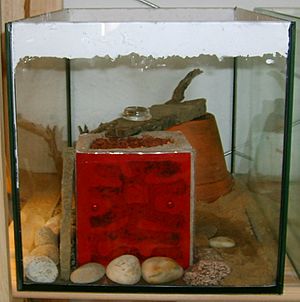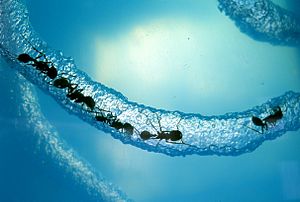Formicarium facts for kids
A formicarium or ant farm is a vivarium which is designed primarily for the study of ant colonies and how ants behave. Those who study ant behavior are known as myrmecologists.
Materials
Most formicarium types now available on the market are either made of acrylic (plastic) or 3D printed. These are superior to the 'sandwich' type formicarium as there is no chance of tunnel collapse, and they are designed more specifically to keep queen ants with workers, whereas the 'Milton' type nests were only designed to house worker ants.
A 'sandwich' formicarium is usually a transparent box made of glass or plastic, made thin enough so that the tunnels and cavities made by the ants can be seen and their behaviour can be studied. The fill material is typically soil, loam, sand, vermiculite, other mineral fragments or sawdust.
Formicariums containing gel that act both as fill material and partially food are available. However, they do not provide the ants with adequate housing and nutrition for the long term and in some instances, they can actually be poisonous to the ants. The formula and nutritional content of gels vary, but for worker-only colonies they tend to only contain sugar or agar plus preservatives. Most gels are colored blue.
Other types of formicaria are those made with plaster, autoclaved aerated concrete (AAC) or simply with no medium. Plaster nests can be made by placing modeling clay on a glass panel in the form of tunnels and chambers. The plaster is poured onto the mold, and when the plaster dries, the clay is removed and the remaining structure can be used for housing ants. The ants in this type of formicarium are very easily seen. Mediumless formicaria may be in any container, with the ants staying in moist test tubes or other small containers. This also allows for better visibility.
A formicarium can be designed to be free-standing, and not enclosed or lidded like a vivarium. A free-standing design does not require high walls and a lid, but rather relies on barriers to secure the ants within their habitat.
Containing ants inside a formicarium can be a challenge. Several substances are used to repel the ants, including anti-escape oil, petroleum jelly or liquid PTFE, which are applied to the side of the formicarium to prevent escape, as most ant species cannot walk on these slippery or sticky surfaces. Despite this, some species of ants can build bridges of debris or dirt on the substance to escape, while in other species some individual ants can walk on the substance without impedance. Formicarium owners often make use of two or more security measures. Another escape-prevention technique involves placing the entire formicarium in a shallow container of water, creating a moat.
Some ant-keepers choose to put their ants into a 'test tube outworld' before a formicarium as this allows them to keep the colony comfortable and safe within their test tube whilst also allowing them a foraging area.
Laws on keeping ants
In the United States of America, it is usually illegal to ship live queen ants across state lines without a permit, and most ant farms sold in the US contain no queens. Professional ant shops and suppliers may ship ants only within the state where they reside.
In the European Union, some domestic species are protected, and it is illegal to own, keep, buy, or sell these ants, or to damage their nests. Unlike reptiles and spiders, there are no laws on owning, keeping, buying, or selling tropical ants. Most formicaria are designed to house queen ants; professional ant shops and suppliers usually sell their colonies with queens.
Images for kids




